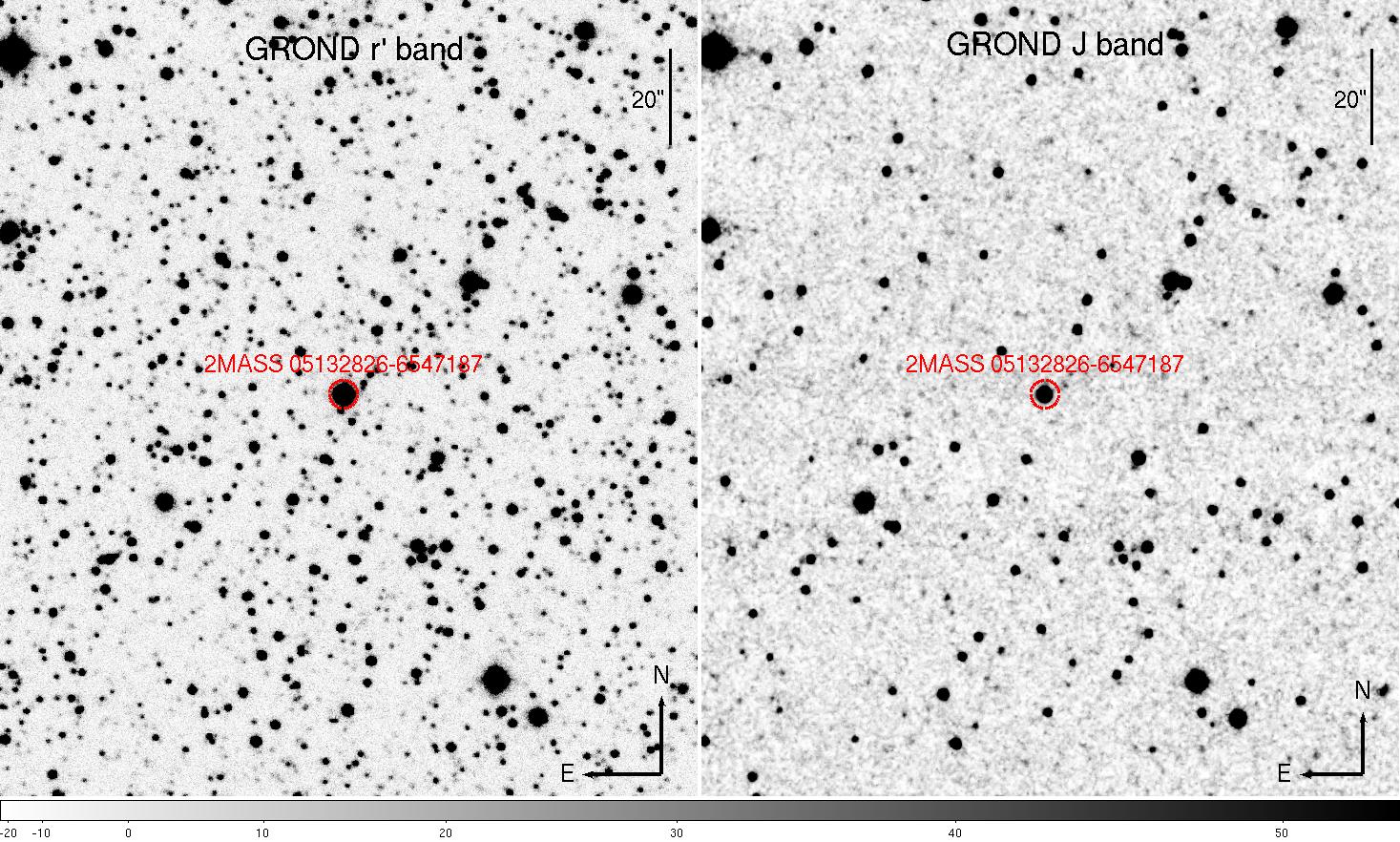
SWIFT J0513.4-6547 = 2MASS 05132826-6547187

 Previous ATELs
Previous ATELs
- ATEL 2011
(14 Apr 2009; 20:38 UT)
Swift and RXTE report the detection of a new transient pulsar
Swift J0513.4-6547 in the Large Magellanic Cloud
- ATEL 2012
(15 Apr 2009; 22:16 UT)
Optical Light Curve of the X-ray Pulsar Swift J0513.4-6547
 ATEL 2013
(15 Apr 2009, 22:25 UT)
ATEL 2013
(15 Apr 2009, 22:25 UT)
J. Greiner, P. Afonso, T. Krühler, A. Rau (MPE Garching)
GROND (Greiner et al. 2008, PASP 120, 405), the 7-channel imager mounted at
the 2.2m ESO/MPI telescope at La Silla Observatory (Chile) started
follow-up observations of the transient source Swift J0513.4-6547
(Krimm et al. 2009, ATEL #2011) on 14 Apr 2009, 23:55 UT simultaneously
in the g'r'i'z'JHK bands. A total of 8 30-sec exposures in g'r'i'z' and 48
10-sec exposures in JHK were obtained.
Within the 1.9 arcsec Swift XRT error circle (Krimm et al. 2009, ATEL #2011)
we detect a single source, at position RA(2000.0) = 05:13:28.29,
Decl.(2000.0) = -65:47:18.9 with an error of 0.3 arcsec. This is consistent
with the object 2MASS 05132826-6547187, already proposed by Krimm et al.
(2009, ATEL #2011) as the optical counterpart of Swift J0513.4-6547.
We measure the following magnitudes (all in AB system):
g' (AB) = 14.6 ± 0.1
r' (AB) = 15.0 ± 0.1
i' (AB) = 15.1 ± 0.1
z' (AB) = 15.3 ± 0.1
J (Vega) = 14.7 -> J (AB) = 15.6 ± 0.1
H (Vega) = 14.6 -> H (AB) = 16.0 ± 0.1
K (Vega) = 14.6 -> K (AB) = 16.4 ± 0.1
Compared to the 2MASS magnitudes (exposures from 10 Dec 1998) of
J (Vega) = 15.2 mag, H (Vega) = 15.1 mag, and K (Vega) = 14.8 mag,
as well as the DENIS magnitudes (exposures from 22 Dec 1996) of
I = 15.09 +/- 0.04 mag and J (Vega) = 15.20 +/- 0.14 mag, this
object is now about 0.5 mag brighter.
The majority of high-mass X-ray binaries are Be/X-ray systems,
in which the blue part of the optical spectrum is usually dominated
by the mass donor, and the red part normally has a significant
contribution from the circumstellar disk. Our foreground-extinction corrected
color r'-z' = -0.5 mag corresponds to about R-I = +0.55 mag, which is
incompatible with the colors of an O or B star. This suggests that already
the z'-band is strongly affected by the putative disk.
Optical variability in Be/X-ray binaries is not unusual, and amplitudes of
up to 0.8 mag over time scale of years have been reported (e.g. Coe et al.
2005, MN 356, 502). While X-ray outbursts are normally associated with the
passage of the neutron star close to the circumstellar disk, our
observations indicate a substantial brightening of the disk, suggesting that
possibly increased mass loss of the donor is responsible for both, the
brightening as compared to the 2MASS/DENIS epochs, as well as the X-ray
outburst.
We urge for spectroscopic observations to measure the strength and width
of the expected emission lines. Given the relatively low degree of crowding
(see finding chart at http://www.mpe.mpg.de/~jcg/xrt/swiftj0513p4m6547.html),
a search for long-term variability in archival data might also be interesting.

GROND image of Swift J0513.4-6547 in the r' and J bands.
Back to JG's
homepage
Jochen Greiner, last update: 15-Apr-2009
![]() Previous ATELs
Previous ATELs 